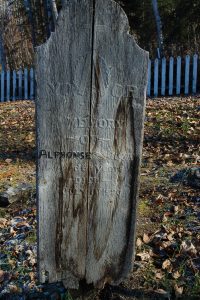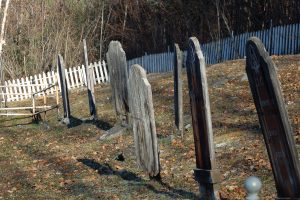A Personal Account of our Visit to Dawson
So many of our guests at Hidden Valley Bed and Breakfast ask about Dawson City, and whether it is worth a visit. Up until recently, I had never been to Dawson, so I could not speak from experience.
Scott and I decided to remedy that. We spent a weekend in Dawson City (called Dawson by Yukoners) in early October. Getting to Dawson from Whitehorse is an easy 5.5-hour drive on the well-maintained Klondike Highway North.
On the drive up, we were lucky enough to spot a huge black wolf on the highway. It was a special moment because we both have an affinity for wolves. It was our first time seeing a black wolf. This image is not ours; but it shows you what this beautiful creature looks like.

When we got to Dawson, we were not prepared for the “Wow Factor”. I lost count of how many times I shouted “look at that!” If you love history and architecture, you’ll be absolutely enchanted with Dawson.
For us, the highlights were the beautiful historic buildings ranging from well-preserved colourful businesses, institutions and houses, to the dignified structures that were proudly showing their age.

To be honest, the gracefully aging silver wood, splintered boards, faded signs and barely discernable paint of these latter structures touched me more than I can say. These buildings give the impression that they are simply resting their bones after giving shelter to so many people for so many years. So they sit—proud and dignified—until it is their turn for restoration.
We spent some time in a graveyard that appeared to be reserved for the Freemasons members. There is a gorgeous, historic Freemason’s Lodge in Dawson.

We stayed at the historic Bombay Peggy’s, which is a historic brothel. This beautifully restored Victorian building is open for business between February and early November.
A couple of tips if you’d like to stay at Peggy’s: bring your slippers, because like Hidden Valley Bed and Breakfast, Peggy’s is a “shoes-off” establishment. Also, there are several sets of narrow stairs to climb depending on which room you reserve. So if stairs are difficult for you, choose one of the first-floor rooms.
We were in Dawson during the off-season, and many of the businesses were closed. But we had plenty to do exploring the town and looking at all the incredible historic buildings.
We enjoyed meeting the people who live and work in Dawson, because—like most Yukoners—they were friendly and hospitable.
Another thing we loved about Dawson was the vibe. It’s quiet there. Really, really quiet. One evening I stood in the middle of the road and soaked up the absolute serenity. If you are still enough, and you “listen”, you can hear the voices from the past calling you. The people from the Gold Rush are still there, just beyond the veil.
So with that wee bit of romantic fluff off my chest, here is a bit of history of Dawson City, Yukon.
Dawson City and Gold Rush
Dawson is the heart of the Klondike Gold Rush. On 17 August 1896, George Carmack, Dawson Charlie and Skookum Jim found gold on Rabbit Creek (now called Bonanza Creek), which is a tributary of the Klondike River.
Word of this find quickly spread, and other Yukon settlements were abandoned as people rushed to stake their claims. Two of these Yukoners—Joe Ladue and Arthur Harper—were quick to purchase, stake and establish the town site of Dawson (named for Canadian Geologist George Mercer Dawson) at the confluence of the Yukon and Klondike rivers, about 20 kilometres from the first strike on Bonanza Creek.
The World Rushes to Dawson
News of the gold strike reached the outside world in July of 1897, when miners from the previous season steamed into San Francisco and Seattle with their gold. News spread like wildfire of a land where “nuggets could be picked off the creek floor”. This caused a human stampede of approximately 100,000 people who set off for Yukon to make their riches. Most would need to travel over 5,000 km to get to Dawson City.
So few knew what their journey would entail. They followed treacherous routes that involved uncharted landscapes, snow-choked mountain passes and freezing rivers. So many died before they made it to the land of gold. But it wasn’t all about the prospect of riches that drew these adventurous souls. It was the lure of the wild, the adventure and the dream of a new frontier.
Dawson continued to thrive until gold was found on the beaches of Nome, Alaska in 1899, many of the same people who came seeking fortunes in the Klondike, left Dawson in a new rush.
From 1896 to 1899, $29 million in gold was pulled from the ground around Dawson City.
The Klondike Gold Rush changed the landscape of the northwest and of North America forever. Transportation to the West and North were vastly overhauled to sustain the Rush. Towns such as Victoria, Vancouver and Edmonton owe much of their development to the Klondike Great Rush. The North became accessible, attainable and, at least in the mind of the common man, conquerable.
Today, this spirit can still be found in Dawson. Although the rush is over, Gold mining still thrives, and the adventure it takes to get here, although less arduous is still a reality.
During the gold rush heyday, there were between 30,000-50,000 people in Dawson. The 2011 census counted 1,400 people. The primary economy now is tourism, mining and government.
How They Extracted the Gold: Placer Mining
The mining method for extracting gold was then, and is now, mainly Placer Mining.
Placer mining is the ancient method of using water to excavate, transport, concentrate and recover heavy minerals from alluvial or placer deposits. Placer mining techniques are used to extract gold from sands and gravel that settle out at points where the current slows down in rapidly moving streams and rivers.
Placer mining takes advantage of gold’s high density, which causes it to sink more rapidly from moving water than lighter, siliceous materials.
Though the basic principles of placer mining have not altered since early times, methods have improved considerably.
Dawson City Today

Dawson boasts an eclectic mix of arts, culture, wilderness and history. Placer miners, artists, adventurists, first nation’s persons, old-timers and new-timers effortlessly share the town.
As mentioned, some of the buildings look brand-new, and others have that quiet “resting” look to them.
When to Visit
The main season for visiting Dawson is between 1 May and 30 September. That is when everything is open. The Visitors’ Information Centre (VIC) is open from 1 May-30 September, from 8am to 8pm. From May to September, the VIC can be reached by calling 867-993-5566, or by emailing vrc.dawsoncity@gov.yk.ca. Things slow down between 1 October and 30 April, which is the off season. If you’d like to visit in the off season, call the Klondike Visitors Association at 867-993-5575 for information.
Now when our guests at Hidden Valley Bed and Breakfast ask about Dawson, we can unequivocally say that they should take the time to visit!









